
Do you have a question about the Toshiba 29L1350U and is the answer not in the manual?
Provides support contact info and troubleshooting references.
Section to record TV model and serial numbers for dealer communication.
Cautions against exposure to rain, moisture, and unauthorized cover removal.
Guidelines for proper grounding of CATV systems as per NEC.
General safety recommendations for TV placement and use to prevent injury.
Guidance on safely mounting the TV to walls or ceilings.
Cautions for handling a dropped or damaged TV, including glass and liquid hazards.
Instructions for securing the TV to prevent tipping using straps.
Warning about antenna installation near power lines and during lightning.
Steps and considerations for mounting the TV using a wall bracket.
Table specifying VESA hole patterns and screw sizes for TV models.
Explanation of icons used to denote risk levels in safety instructions.
Eliminates need for separate digital converter box for most broadcasts.
Supports digital, high-definition multimedia interfaces with 1080p input.
Allows control of external devices via TV remote using HDMI CEC.
Enables viewing photo files and playing music files via USB.
Indicates TV power status with a green light when on.
Embedded sensor for receiving remote control signals.
High-definition multimedia interface input for digital audio and video.
Component video input, shared with composite video input.
Guide to connector types required for various audio/video devices.
Connects antenna, cable TV, or converter box to the ANT/CABLE input.
Connects composite video and analog audio from devices.
Connects component video for better picture quality.
Connects receivers with Dolby Digital or PCM optical audio input.
General notes on connection diagrams and device variations.
Lists necessary cables like coaxial and standard AV cables.
Select ANT/CABLE input source to view antenna or cable signals.
Receives digital audio and uncompressed digital video from HDMI/DVI sources.
Enables control of connected devices using TV remote via HDMI CEC.
Connects TV's digital audio out to external audio systems using optical cable.
Connects TV's analog audio outputs to external amplifiers for sound adjustment.
Uses analog RGB and PC audio cables to display computer output on TV.
Connects computer to TV via HDMI using an HDMI or HDMI-to-DVI cable.
Step-by-step instructions for inserting AAA batteries into the remote control.
Lists and describes buttons on the remote for TV operation.
Overview of TV menu items for Picture, Sound, Options, and Installation.
Explains how to use remote buttons to open, navigate, and save menu settings.
Guides through initial TV setup including language, time zone, and input selection.
Allows saving preferred channels for easier tuning.
Automatically detects and stores active channels in the area.
Allows skipping specific channels to prevent viewing.
Configures audio mode for HDMI 1 input (PC or HDMI).
Resets all TV settings and channels to their original factory values.
Guides on how to choose the active video input for viewing.
Allows custom naming of video inputs for easier identification.
Provides an interface for navigating and selecting channels and inputs.
Allows creating and managing a list of favorite channels and inputs.
Procedures for tuning analog and digital channels directly.
Options for adjusting picture aspect ratio to fit various program formats.
Automatically selects picture size based on input source.
Allows freezing the current video image temporarily.
Offers preset modes like Dynamic, Standard, Movie, Game, PC.
Allows fine-tuning of Backlight, Contrast, Brightness, Color, Tint, and Sharpness.
Options for displaying dialogue, narration, and sound effects on screen.
Controls for partially reducing or turning off the TV's audio output.
Enables high-fidelity stereo sound and second audio program (SAP) reception.
Sets the audio output format for digital audio systems connected via optical cable.
Procedure to set a PIN for menu access and parental controls.
Uses V-Chip feature to block programs based on selected content ratings.
Locks video inputs and channels to prevent unauthorized access.
Sets a time limit for video gaming, locking inputs upon expiration.
Locks TV control panel buttons to prevent accidental changes.
Adjusts image parameters like position, clock phase, and sampling clock for PC input.
Guidelines for enjoying photos and music from USB storage devices.
Describes methods to start the Media Player, including auto and manual start.
Displays photos in a grid format using thumbnail data for easy browsing.
Displays photos located in the selected directory, allowing manual content change.
Allows watching a slideshow of photos with options to skip, repeat, and set time.
Instructions for selecting, playing, pausing, and managing music files.
Allows setting a timer to automatically turn off the TV after a specified duration.
Introduces HDMI CEC feature for controlling connected devices.
Lists remote buttons used for controlling HDMI CEC playback devices.
Guides on configuring HDMI CEC features like Auto Power and Amplifier Control.
Shows TV status like current input, resolution, and audio format.
Explores settings for ColorMaster, Base Color Adjustment, and Color Temperature.
Adjusts picture color quality using Cool, Medium, or Warm presets.
Adjusts the levels of black detail in the picture.
Strengthens black coloring in dark areas based on video content.
Provides smoother motion for DVD playback.
Reduces visible interference and video noise from signals.
Initial steps before calling service, including unplugging and replugging TV.
Addresses issue where a black box appears, related to closed caption text modes.
Troubleshooting steps if the TV buttons or remote are unresponsive.
Addresses issues where a demo screen appears, suggesting reset to Home mode.
Troubleshooting steps for when the TV fails to power on.
Addresses issues like noisy picture, color loss, sync problems, and poor composite video.
Troubleshooting steps for audio issues such as no sound or incorrect audio.
Steps to resolve issues with the TV's remote control not functioning correctly.
Troubleshooting steps for when HDMI CEC features are not functioning.
Solutions for issues encountered when using the Media Player with USB devices.
Details NTSC, ATSC, and Digital Cable television standards supported.
Lists the maximum current draw for each TV model.
Specifies the audio output power in watts for each TV model.
Describes the specifications of the video and audio input terminals.
Provides the weight specifications for different TV models.
Lists acceptable signal formats and frequencies for PC input.
Lists acceptable signal formats and frequencies for HDMI input.
General information about software components and licensing terms.





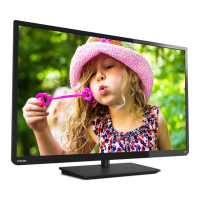

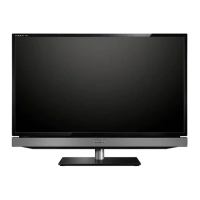

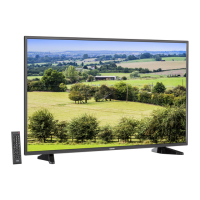
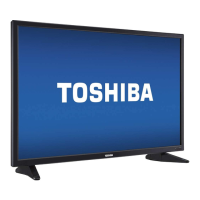
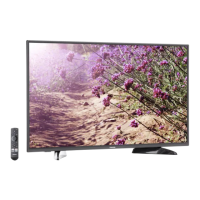
